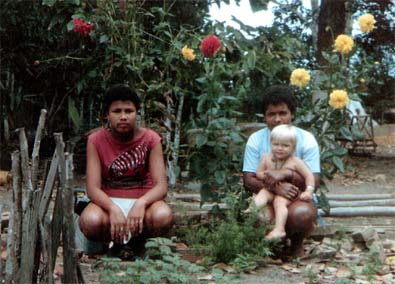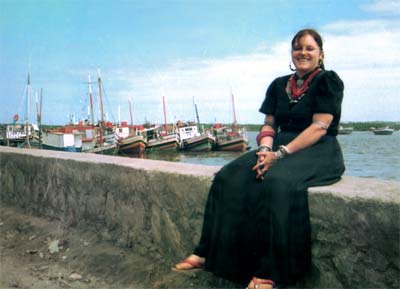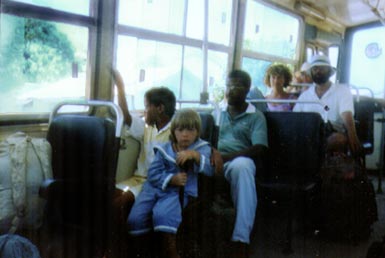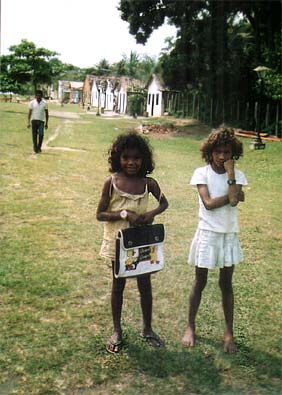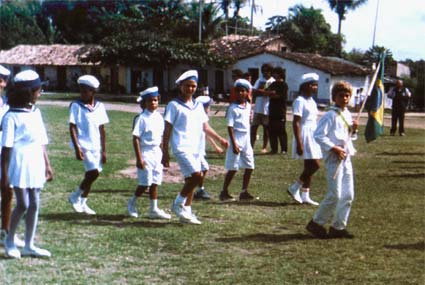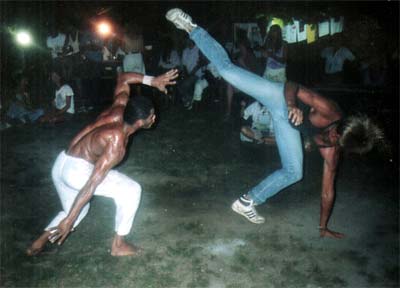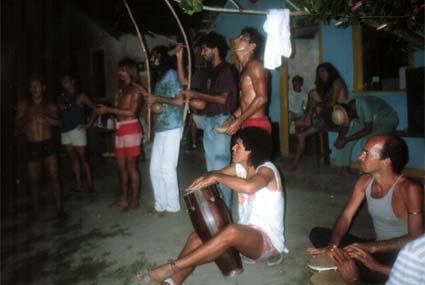| |
|
|
|
|
| |
|
|
|
| |
|
After the house was ready and the restaurant
had opened, our life in Trancoso started to get a certain structure. |
|
|
| |
|
The first couple of months we had spent getting the feel of
the place, plying snooker and acquainting ourselves with the new language
and local customs. It was a somewhat boring period, there was nothing to
do actually except waiting for things to start moving. In this time we first
noticed how big the difference was between the orient and Brazil. |
|
|
| |
|
|
|
|
| |
|
|
|
|
| |
|
my favorite window |
|
|
| |
|
|
|
|
| |
|
Daily life consisted of getting up around seven, woken by
the noise of my kitchen helpers, usually some young girls from the neighborhood,
entering and getting busy clearing away the debris of last night's cooking.
I do admit to being a rather messy cook, my excuse being that it's impossible
to be both creative and orderly at the same time. |
|
|
| |
|
I was glad to have a few girls around to do the chores I didn't care for.
This left me ample time to do what I like and I'm good at, which is anything
that challenges my creativity. |
|
|
| |
|
Most village housewives were meticulous housekeepers. It was most impressive
to see how they managed to polish a crude concrete floor until it was as
smooth and shiny as a mirror. On the other hand, I think they could have
used their time better for something more constructive, like maybe reading.
Actually reading wasn't at all popular, there was not a single newspaper
available in the village. One of my friends and neighbors used to "read"
once in a while, to her that meant going again and again over the same old
tattered religious pamphlet that was the only readable text she owned. |
|
|
| |
|
|
|
|
| |
|
|
|
|
| |
|
Zezé
and Sueli, two of my helpers in the kitchen and around the pousada |
|
|
| |
|
|
|
|
| |
|
Off season, by far
the bigger part of the year, the restaurant only opened in the evenings for
dinner, which gave me ample time to prepare the meals with much care and no hurry.
I liked it when friends came by to sit in the kitchen while I worked, we'd
talk, laugh and have a good time. During the short tourist season I also had toprepare breakfast for the guests. |
|
|
| |
|
|
|
|
| |
|
Depending on the actual state of things, I had to confer with
our construction workers about the ongoing work. They'd learned to call
me before doing something rather than redoing it later because a certain
arch didn't have the curve it should or an ornament looked wrong. |
|
|
| |
|
|
|
|
| |
|
Shopping was complicated and took up much time. Not only
did we need groceries and fresh vegetables for the restaurant; household
items and construction supplies also had to be bought or ordered. I regularly
made the bus ride to the edge of the bay and across by ferry to Porto
Seguro. Trancoso had only one small store with a very limited choice of
items and prizes much higher than in Porto, which boasted at least three
medium size supermarkets were located. On the wharf was a place to buy
fresh fish, and some old timers had set up a few rickety wooden tables
where they'd clean and cut the purchased fish according to the customer's
preferences. |
|
|
| |
|
|
|
|
| |
|
|
|
|
| |
|
typical Porto Seguro residential
street |
|
|
| |
|
|
|
|
| |
|
Due to sky rocketing hyper-inflation it was advisable to compare
prizes in all three shops first, they changed on a daily basis. In all supermarkets
one could usually find some salesclerks occupied with changing prize labels
on all merchandise. I found a batch of tins of asparagus on the lowest shelf
in a store once, a vegetable hardly known or bought by locals. Accordingly
they didn't get their prize renewed for a couple of months and cost only
a fraction of their real value. |
|
|
| |
|
If I was lucky, my groceries were delivered to a street
corner near the ferry by one of the bicycle boys employed at the stores.
I still had to carry the heavy cartons and wooden boxes down to the boat
though and up again to the bus stop on the other side. |
|
|
| |
|
|
|
|
| |
|
|
|
|
| |
|
waiting for the ferry |
|
|
| |
|
|
|
|
| |
|
In bad weather there was always the danger of an old bridge,
consisting only of roughly hewn wooden beams, being defect or impassable,
or the muddy inclines leading down and up again where too slippery for vehicles.
So at times, the bus would stop up on the ridge on one side of the small
river, all the goods had to be carried down to and over the bridge and up
again, where a second vehicle waited to pick the passengers up. |
|
|
| |
|
|
|
|
| |
|
The next bigger town after Porto was Eunapolis, farther inland
and some 80 km from Trancoso, an unappealing place with one of the highest
crime rates of the region. It was there we bought tools and different construction
materials like coloured glass for windows and ornaments, and also fabrics
for clothes. Getting to Eunapolis and back was a full day trip, undertaken
in our jeep when someone with driving skills was available, otherwise by
bus from Porto Seguro. |
|
|
| |
|
|
|
|
| |
|
|
|
|
| |
|
Ahmed and Quito sharing a seat on
the bus to Porto |
|
|
| |
|
|
|
|
| |
|
Prizes actually increased by 400% during my four years in
Brazil. Foreign exchange had to be converted to local currency only on the
day it was needed, to avoid any loss due to daily changing rates. We had
arrived with some traveler checks, and to cash them in at that time only was
possible in Salvador da Bahia, 600 km or a long night's bus ride from
where we lived. |
|
|
| |
|
I loved to visit the splendid previous capital of Brazil with
its majority of black people, tiny bars on steep narrow alleys
selling home made liqueurs from dusty bottles, and white-robed Bahianas
sitting on street corners deep-frying local dishes with African names
like carurú, vatapá and acarajé
in bubbling dendé, red palm oil. |
|
|
| |
|
Bahia, as Salvador, beautifully situated on the shores of
the huge Baía de todos os Santos, is generally called,
is a town of religion and mystery, of magic and cults. Catholicism
co-exists and often merges with candomblé, the black gods
and white saints exist side by side. Both are evoked to assist their suppliants
in handling and influencing their worldly affairs. Priest hold mass
in their lavishly decorated churches with gold-gleaming interiors
while on the next block maes dos santos in head scarves
and long robes whirl in trance and communicate with the old African gods. |
|
|
| |
|
The places we changed our traveler checks at were some mortician's
stores in the historical town of Salvador, with coffins displayed both in
the shop windows and inside. |
|
|
| |
|
|
|
|
| |
|
After a year or so in Trancoso, Fatima's Portuguese was well
enough for her to enroll at the local school. The drab concrete school building
consisted of only two rooms in the beginning, and classes didn't go further
than fourth grade. A few years back, the sole tuition available had been
lessons given by an elderly lady, a retired schoolteacher I think she was,
at her home. |
|
|
| |
|
|
|
|
| |
|
With time, a bigger school was built, and classes in higher
grades were added. Hundreds of Brazilian families from the interior moved
to Trancoso, where the resident foreigners provided some hope of finding
work in construction, so the facilities of the new school weren't sufficient
either, and classes had to be held in shifts until late at night. |
|
|
| |
|
To qualify as a teacher in Trancoso, not much more then a
basic knowledge of the alphabet was necessary. Some teachers were volunteers
from the southern states who happened to get stuck in the village. One of
my kitchen helpers aspired to the noble calling as well, despite not being
able to write a grammatically halfway correct daily menu on the blackboard
out front. |
|
|
| |
|
Fatima would get up by herself every morning and groom herself
nicely for school. In maybe her third year, her grades in Portuguese were
getting better than those of her native friends, who weren't pleased at
all. |
|
|
| |
|
|
|
|
| |
|
|
|
|
| |
|
two of Fatima's schoolmates |
|
|
| |
|
|
|
|
| |
|
Rashid didn't learn as easily. When we had left Nepal, he
didn't speak much German yet, he had communicated with Fatima and their
playmates in basic Nepali. Since he hardly ever was home in Trancoso, his
German didn't improve. He instead picked up the local dialect, far removed
from proper Portuguese, where, as an example, flor was pronounced
fro. |
|
|
| |
|
|
|
|
| |
|
One unforgettable afternoon I was busy in the kitchen when
Rashid appeared and started to talk to me very rapidly. My own Portuguese
by then was about passable, but I had acquired it not only from the locals,
but as well from talking with better educated friends from other states,
and from reading comics. So on that day, when my son stood in front of me,
excitedly babbling in heavily accented local lingo, I couldn't understand
a word he said. I asked him to slow down and speak more clearly, to no avail.
I urged him to try in German, but it was hopeless. The more frustrated he
got, the less I understood. His face colour changed first to red and soon
to purple, his big eyes were brimming with tears and he looked as lost as
I felt myself on realizing I couldn't communicate with my own child. Finally
I had to call for one of my kitchen girls to find out what Rashid was trying
to tell me. |
|
|
| |
|
|
|
|
| |
|
Little Ahmed didn't pick up any German from me and his father
either, and soon I only talked Portuguese with both the boys. Fatima still
knew some German from a year spent in Stuttgart when she was four. |
|
|
| |
|
|
|
|
| |
|
Two years after Fatima entered school, it was Rashid's turn,
though he didn't show the same enthusiasm as his sister. Rashid and his
friends, as young as they were, proved to be indomitable for their first
volunteer teacher, a nice, soft-spoken girl from Minas Gerais. After three
weeks she fled Trancoso, having lost both her nerves and her voice. Next
came a rather impressive young woman, a heavyset Obelix look-alike, whom
I expected to have more standing power. She capitulated after one month. |
|
|
| |
|
Only a real tough lady from Rio and village nymphomaniac by
reputation managed to get the boys sorted out in the end. |
|
|
| |
|
|
|
|
| |
|
|
|
|
| |
|
Rashid (center) at school parade |
|
|
| |
|
|
|
|
| |
|
In the first year of school, daily lessons amounted to one
and a half hours only. Not much actually, but seemingly still too much for
Rashid and his mates. I learned from the teacher that often my son didn't
turn up at school at all, or if he did, he came late and left at intermission. |
|
|
| |
|
On being questioned about the reasons for not attending
classes on a certain day, Rashid gave me one of his innocent looks and
explained they'd been busy helping a mate to transport some wood back
to the village with his father's ox. In the boys' opinion, and in only
too many adults' as well, any such activities naturally were of higher
priority than attending classes. |
|
|
| |
|
It got worse after I left Brazil. Rashid had to repeat third
grade thrice due to falling short of the required number of hours of yearly
school attendance. |
|
|
| |
|
Only many years later I learned from my son how naughty he
and his friends had actually been. He told me stories like the one about
how his best mate used to ask permission to visit the loo during lessons.
This being granted, he'd escape, or, on the refusal of the teacher, who
well knew his intentions, he'd piss right on the classroom floor. Another
pastime of those little malandros was to explode self made bombs outside
the classroom windows. |
|
|
| |
|
|
|
|
| |
|
Woe to the teacher who dared cuss out an unruly pupil. Fathers
would appear at the school building foaming at the mouth and brandishing
machetes, defending their blameless little lambs against the injustices
of the scholastic world. |
|
|
| |
|
|
|
|
| |
|
One of Rashid's mates once asked his father if
he couldn't take off a year from school. The father, of a generation that
hadn't gone to school at all and still was not completely convinced of the
importance of such customs, acquiesced easily. In hindsight, it maybe wasn't
so wrong a decision, because the lad later died at the age of nine. |
|
|
| |
|
|
|
|
| |
|
In the evenings, the village green served as a soccer field
where the younger men, after ending their workday, gathered for a game,
watched by their female contemporaries. On Sundays some more important matches
were played, often against a neighboring village. Half the place, grandmothers
and matrons included, would watch the Sunday games, relaxing in front of
their own houses or those of relatives bordering the quadrado. |
|
|
| |
|
Among the girls, futbol was very popular
as well, and Fatima, the only one of my kids who loved to play soccer, wished
to join a girls team. I tried to talk her out of it, not liking the idea.
Most of the players were of rather stocky, square build, with the grace
and power of steamrollers, and I feared the worst for my girl's more delicate
bones. |
|
|
| |
|
|
|
|
| |
|
Something else the kids liked was to watch TV. We never had
owned a TV set in Nepal, and neither did I want one in Brazil. When I needed
Fatima, I often found her at our neighbor's, sitting on the parlor floor
among a group of friends, their eyes glued on the latest "telenovela". |
|
|
| |
|
|
|
|
| |
|
As the village grew, new types of recreational
activities were introduced. Capoeira, a kind of weaponless defense
developed by negro slaves, who were prohibited to carry arms, evolved into
a fashionable sport all over Brazil, and was, contrary to tradition, embraced
by women as well. Meanwhile, Capoeira has spread to all corners
of the world, and there is hardly town in Europe or Northern America without
at least one school of it, led by some mestre of minor or major
fame. |
|
|
| |
|
|
|
|
| |
|
|
|
|
| |
|
Capoeira in Trancoso |
|
|
| |
|
|
|
|
| |
|
Two opponents "fight" against each
other, though the fighting is rather a very elegant and acrobatic type of
dancing, the two players whirling and jumping to the sound of the accompanying
music of drums and berimbau and the traditional songs sung by the
circle of their friends and fellow capoeiristas.. |
|
|
| |
|
|
|
|
| |
|
|
|
|
| |
|
drums and berimbau accompany
the capoeiristas |
|
|
| |
|
|
|
|
| |
|
Trancoso has no real tradition of Capoeira,
unlike the state capital, Salvador da Bahia. But among the Brazilian
drifters and dropouts hanging out in the village, there were always a few
who knew how to play, and would gather to show their art in the evenings. |
|
|
| |
|
For more info on Capoeira click below. |
|
|
| |
|
|
|
|
| |
|
|
|
|
| |
|
Brazil
had (and I assume still has) a very strict policy against the use of marijuana.
I've heard accounts of electroshock therapy being applied to offenders still as late as the
eighties. Luckily, due to the absence of a police station in our village,
grass could be smoked in relative peace. Not too openly, but inside buildings
or in the quintals, the backyards, joints could be passed around
without causing problems. We had our pond in the garden to sit around, or
the roof of the small pousada building. |
|
|
| |
|
|
|
|
| |
|
A funny and memorable incident comes to my mind,
starting with a respected local man and a butcher by profession paying us
a visit one afternoon, hinting he had come as a friend to give some important
advice concerning a certain matter. He didn't outright declare his mission,
and when he did after settling down with a cold beer, we were all the more
perplexed. "It's about the pé", he confided in
hushed tone. The pé??? |
|
|
| |
|
Now pé means two things, first
it's the Portuguese word for "foot", and second it's used in relation
to plants, mainly trees or bushes, as in "pé de laranja"
for example, meaning an orange tree. |
|
|
| |
|
We still had no clue, and our visitor
further mystified us by producing a small card from his wallet, identifying
him as a police agent, but reassuring us at the same time that he had come
as a friend. Someone had informed him that we had a "pé
de maconha", a cannabis plant, in our garden! |
|
|
| |
|
A quick check proved him right, one solitary
grass plant really stood near the pond. Only we had never noticed it, it
must have grown from a dropped seed. As the corpus delicti stood
in full view of a somewhat unpleasant neighbor, it was not difficult to
deduct who had ratted on us. |
|
|
| |
|
Mr. Secret Agent told us to uproot and destroy
the offender, which we immediately did, having no use for a male plant anyway. |
|
|
| |
|
|
|
|
| |
|
One day around Christmas in our second year in
Trancoso, a guy who'd just come up from the south told us about a boat at
sea who, for unknown reasons, had thrown its cargo consisting of first grade
marijuana, sealed
in tins, overboard somewhere near Rio. Well, Brazil is full of stories,
and not half of them are true. That's what we thought. |
|
|
| |
|
About two weeks later though, another friend
returned to Trancoso not only with the same story, but with some samples
of the grass. It was terrific, after smoking only one jillum I
felt like walking on air on the way back to my kitchen. One thing
was for sure: That wasn't local stuff. As to where the boat's cargo had come
from, nobody knew, but a lot of guessing went on. |
|
|
| |
|
Now this friend told us how he and some mates
had been relaxing on a beach in some southern town, when they had noticed
a few big tin cans lying around. Curious, they picked one up and opened
it, and couldn't believe their eyes: It was filled to the brim with grass.
No question, they gathered all the tins they could find. What a welcome
Christmas surprise for hundreds of potheads all along a great stretch of
the sea shore, and a great story to one day tell their grandchildren, who
of course will not believe one word of it! |
|
|
| |
|
|
|
|
| |
|
Unfortunately,
the use of cocaine is very popular in Brazil too. I've witnessed some rich
dude ordering an empty plate to snort his "dessert" right at his
restaurant table. As much as I'm convinced that cannabis is a benevolent
mind opener, as much I'm against cocaine as a "recreational" drug. |
|
|
| |
|
It's conceivable that some natives in the Andes
chew the leaves of the coca plant without too many adverse effects, after
all it's a traditional part of their culture. I've never been there and
therefore I don't know. What I do know though is that cocaine powder is
one of the most dangerous drugs around. |
|
|
| |
|
|
|
|
| |
|
The repercussions of coke abuse on the mind are
bad enough: Dumb people feel so great and enlightened that as soon as the
illusion ceases, they have to take another snort. I've spent endless hours
watching folks high on coke when my ex was partying with his friends. Everyone
thinks he's talking pure philosophy, when actually it's complete bs that
doesn't make any sense. Two people discussing something at times don't
even notice they're talking about completely different topics. Coke is a
drug that bloats the ego, and is a great danger mainly to people with low
self esteem, who under its influence perceive themselves as brilliant and
in complete control. |
|
|
| |
|
This can go on for a time, sometimes even for
a few years. But the next stage usually is one of hallucinations and terrible
paranoia, up to the point where addicts have delusions like believing that
everybody they know, friends and family included, takes part in a huge conspiracy
to kill them. |
|
|
| |
|
Cocaine also gravely damages bodily tissue, I've
seen photos of brain scans where big lesions were visible, and met people
with actual holes in the bones up their noses. |
|
|
| |
|
More upsetting for me though was the fate of
babies and children of coke abusing parents. The luckier ones who didn't
have grave birth defects still were so much slower in their development
than their contemporaries. One little girl I knew was born with a disease
that spelled total blindness from about the age of 14 years onwards. |
|
|
| |
|
|
|
|
| |
|
A few years after I had left Brazil, I heard about locals
getting involved with the powder as well. Now the rich southerners and most
of the foreigners at least can afford their habit. Natives can't, and coke
being the cause not only of bodily ruin but moral collapse as well for many
a native lad. The first murder of a tourist in Trancoso got committed by
an addicted young local. And a nice woman I knew left husband and three small children
to join a gang of bandits after she got hooked. |
|
|
| |
|
But enough of this exasperating topic. |
|
|
| |
|
|
|
|
| |
|
Through my kids, neighbors and friends I learned about the
local superstitions, fears and legends, which include anything from the
headless mule, mula sem cabeça and the chupa cabra
(literally: goat sucker, a feared beast that reportedly sucks animals
empty of their blood), the latter being known all the way up to up to Mexico,
to beliefs like the one stating that in Brazil men and women exist at a
ratio of 1 : 7. Meaning if for every man their are seven women, staying
with only one deprives six less fortunates of the pleasure of male company.
A good excuse to leave a women when she gets pregnant and move on to the
next one. |
|
|
| |
|
Accounts of supernatural occurrences, of the appearance of ghosts and
of haunted places abound in rural Brazil. |
|
|
| |
|
|
|
|
| |
|
|
|
|
| |
|
Mula sem Cabeça (picture: web) |
|
|
| |
|
|
|
|
| |
|
The Mula sem Cabeça is said to be able
to inflict severe wounds with its sharpened hoofs on the hapless victim
who happens to cross its path. Legend has it that women who committed
some wrong, especially those having a love affair with a catholic priest,
turn into such frightening creatures with roaring flames in place of a
head on Thursday nights. |
|
|
| |
|
Though in Trancoso, the Mula sem Cabeça only appears in
the Semana Santa, at Easter Holiday, after midnight. |
|
|
| |
|
|
|
|
| |
|
|
|
|
| |
|
|
|
|
| |
|
Saci pererê (picture: web) |
|
|
| |
|
|
|
|
| |
|
A figure well known all over Brazil is Saci pererê,
a one-legged pipe smoking Negro boy with a red cap. Fatima told me that
when she and her friends went to collect wild growing fruit, they were
very careful about not following any bird. It was well known that the
Saci could change into that form and would use it to enthrall the
kids and abduct them. Saci also is known as a mischievous sprite who loves
to play pranks. |
|
|
| |
|
|
|
|
| |
|
There is a kind of a grotto with water dripping from the stones on the
way to Porto , where many people have seen a mysterious old lady appear.
Kids wouldn't go near that place out of fear. |
|
|
| |
|
. |
|
|
| |
|
Considering that in its past Trancoso had witnessed slave trade in all
its cruelty, I'd be the last person to deny the possibility of a few unhappy
and wronged souls still being attached to the place. Whispered insinuations
hinting of a massacre committed on native Indians only a few dozen years
ago, with some of the participants still living in Trancoso, make for even
more violent deaths having taken place in the village's vicinity. |
|
|
| |
|
|
|
|
| |
|
Myself, I have never encountered any disgruntled
spirits though, and I suspect that a great part of such sightings were either
drug or alcohol induced, or in the way rather of what once happened to Fatima
and her friend. One evening after nightfall those two young girls came running
home in panic; trembling with fear they told of a terrible beast with eyes
like glowing embers they had encountered just outside the quadrado.
Curious, I asked them to show me the place where they had seen the
monster. Arriving there, I soon made out the culprit responsible of reducing
two bold girls into shivering scaredy-cats: A discarded, squashed soft-drink
can that lay in the darkness of a small wayside ditch reflected the light
of a nearby street lamp, so producing the two shining spots that the girls'
vivid imagination turned into the luminescent eyes of some ogre lying in
wait. |
|
|
| |
|
|
|
|
| |
|
Another widespread fear was that of the onça,
some kind of a jaguar. At times it was so bad that some people were afraid
to walk around the village after nightfall. One of the girls working for
me was scared enough to refuse to stay alone in the kitchen behind the house
at night. I don't know when the last jaguar was seen around Trancoso, but
during my four years stay nobody actually ever saw one. |
|
|
| |
|
|
|
|
| |
|
One winter, strange stories of discarded children's
bodies found in back alleys of neighboring towns, eyes or organs missing
and wads of money stuffed into their clenched fists made the rounds. Every
stranger passing through the village was eyed with suspicion, and woe to
the one who stroke up a harmless conversation with a local kid. Nervous
mothers kept a much sharper than usual control on the whereabouts of their
offspring, and neighbors watched out for each other. I never was able to
make out if any such incidents of abduction really had actually occurred,
or if all those stories were just urban legends. |
|
|
| |
|
|
|
|
| |
|
|
|
|
| |
|
|
|
|
| |
|
|
|
|
| |
|
|
 |
|


